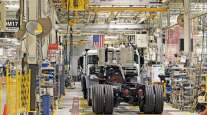Senior Reporter
Prices of Used Class 8s Dip in November; Mileage Declines

The average price of used Class 8 trucks sold in November dipped in a seasonally subdued market where the average mileage continued to fall, ACT Research Co. said.
The U.S. average price declined by 1% to $45,800 a truck from $46,450 a year earlier, ACT said in a Dec. 22 report. The record high of $49,928 was set in May.
ACT said the average mileage year-to-date on used heavy-duty trucks actually sold was 495,929, down 8% compared with 541,613 through the first 11 months of 2014.
ACT surveys dealers, wholesalers and auctioneers, as well as a few large fleets, to compute an average.
“Truck buyers are trading a little bit sooner this year than they did last year, and that’s to take advantage of the more fuel-efficient trucks that are available on the new-truck side,” ACT Vice President Steve Tam said.
Although the mileage is down, the average age increased by 1% compared with October, to 7 years and 7 months.
“A used truck’s condition, in general, depends on where the truck is in the supply chain,” said Chris Visser, an analyst with the National Automobile Dealers Association.
He said high-mileage trade-ins from owner-operators frequently have minor to moderate damage and possibly deferred maintenance. “The receiving dealership will recondition the truck and address outstanding service items, commensurate with the truck’s predicted value. As such, the cleanest trucks available are generally those offered for retail sale on a dealer’s lot.”
Trades from national fleets generally are prized “since they typically have a documented and current maintenance history. The fleets can afford to keep their trucks operating at optimum efficiency,” Visser said.
He said model year 2012 trucks were most popular last month. “That model year saw a price decline of just under 7% on average, with some models faring better than others.”
The retail sleeper tractor market overall lost 5% of its value in November, with the benchmark 3- to 5-year-old group losing just under 3%, Visser said.
Tam added that he has heard from dealers anecdotally that inventories have increased “meaningfully” since the fall. “But they are nowhere near what we had in previous times when we had inventory run-ups.”
He added, “We are not drowning in inventory, so to speak. This is the message that is pretty clear from the industry.”
Visser said that, based on the sample of dealers he tracks, same-dealer sales in November rose by 4% compared with the same month in 2014 and by 1% year to date.
Sequentially, though, November’s 2,004 vehicles sold was 23% lower than October’s 2,592 for the firms contacted.
Visser said it was not unusual that sales were subdued in November. He said retail prices in November were slightly below October prices, probably because dealers were holding onto inventory “waiting to see how the market will unfold in early 2016.”
Tam said the economy’s mixed signals have “spooked” truckers. “That confusion is resulting in hesitancy in buying or ordering trucks right now, although some of the [economic] indicators have started to pick back up in the last couple of weeks. You have [them] pointing in different directions and contradicting themselves over short periods of time.”
But Tam said there “is no reason for [the economy] to fall apart.”
Visser said he expected used-truck volumes to increase by 13% in 2016.
“In 2015, there were approximately 27% more trucks of typical trade-in age in service than in 2014. In 2016, there will be another 13% on top of that figure,” he said. “The ever-increasing price of new trucks will continue to keep an incrementally higher proportion of buyers in the used market, but supply is by far the more critical factor currently.”
New heavy-duty trucks often can cost upward of $140,000.
Visser said all sleeper tractors with less than 1 million miles had an average selling price of $56,572, or $3,281 lower than October, while 3- to 5-year-old sleeper trucks averaged $63,565, or $3,160 lower than October.
Tam said ACT does not expect the shorter trade-in cycle to continue, and fleets eventually will return to longer trade-in cycles. “It’s kind of a pendulum. You shorten [trade-in cycles], but then there is no reason to continue shortening it. So the pendulum swings back, and you get return to stasis, or whatever your norm is.”




